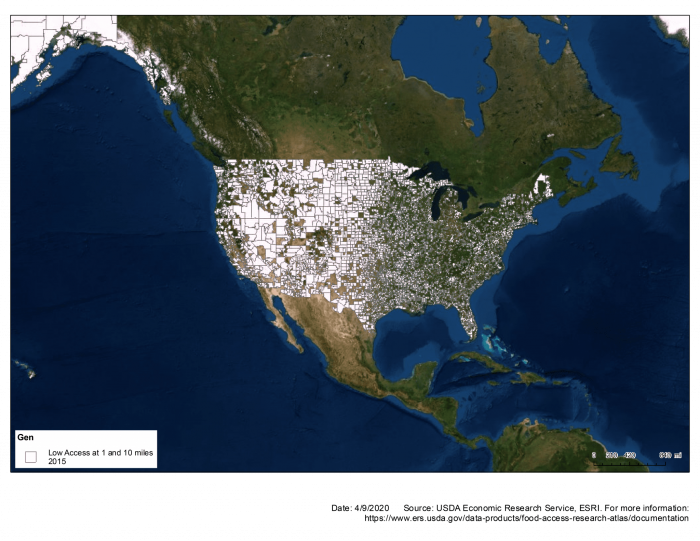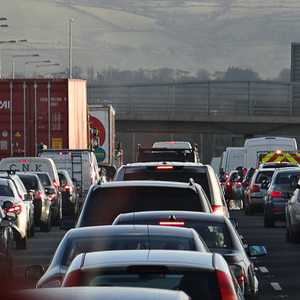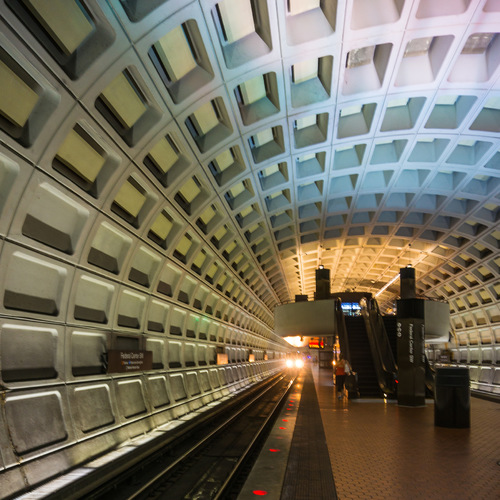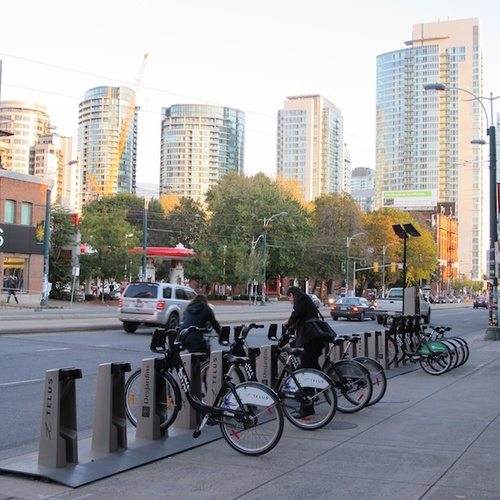
The coronavirus has exposed the ills of continued automobile-centric urban planning practices that adversely impact equity, health, and the climate. Those of us who are working from home, own an automobile, and can conveniently make grocery runs may overlook the fact that many in this country are not so lucky. Many households rely on public transit systems that are struggling to provide service, or they may bear high transportation costs that are exacerbated by a lack of access to the most critical of needs.
There is no technological solution that will solve the systemic problems with our urban land use and transportation policies. We simply need to commit to the development of complete neighborhoods and communities that ensure access to food, healthcare, education, and jobs—without relying on personal vehicles.
In the midst of this crisis, many are pointing to the outbreak of COVID-19 in urban centers like New York City to support anti-density arguments. This sentiment is nothing new in the environmental community, much of which grew out of anti-development advocacy of the ’70s and ’80s. But the world is a different place now, and it’s time for the environmental community to push back on these arguments.
After all, compact and mixed-use neighborhoods—which can include medium or “gentle” density levels—are, by nature, resilient and energy efficient. Barring supply chain collapse, they far outperform suburban communities in their access to food and other critical needs during crises like the one we are currently experiencing.
Why then, do we continue to outlaw this resiliency in most of our cities?
American cities’ insistence on maintaining antiquated zoning and planning policies disconnects communities from economic opportunity, worsens public health, and drives up emissions through increased automobile usage. Many may claim that Americans simply love their cars, but this overlooks the fact that we’ve essentially mandated car ownership through our policies and planning practices.
In fact, 75% of residential areas of cities are zoned for single-family detached homes effectively banning multifamily housing, as well as commercial spaces. The consequences of these policies have become painfully obvious in this crisis, as public transit service declines, businesses shutter, and those less fortunate are essentially stranded in environments that were purposely designed to segregate uses and people.

Telecommuting and EVs
Many of us who are fortunate enough to work from home are acknowledging the potential for “telecommuting,” as traffic volumes plummet in cities around the world and air quality improves dramatically.
While there are some opportunities to reduce vehicle miles traveled via telework, they are limited by the number of jobs that require employees to be physically present, such as construction and hospitality, and the limited number of trips that commuting represents.
Similarly, a strategy to reduce transportation sector emissions using electric vehicles (EVs) alone will not deliver the needed reductions in time. Many in the environmental space discount the role of land use because they assume the electric vehicle market will grow quickly enough to offset our transportation emissions.
These people often reinforce their argument with the assumption that land use policies are too difficult to change and take too long to show impact. I intend to tackle that faulty assumption in a follow-up post, but in the meantime, let’s have a bit of a reality check on the impact of electric vehicles.
Rocky Mountain Institute recently analyzed scenarios for reducing the transportation sector’s carbon emissions by 55% by 2030—a goal set forth by the Intergovernmental Panel on Climate Change’s (IPCC) call to limit global warming to 1.5° Celsius. We found that even if the United States were to sell over 50 million electric vehicles by 2030, it still needs to reduce vehicle miles traveled (VMT) by 30%. This analysis assumes a 39% year-over-year growth rate in the EV market moving forward.
We conducted this analysis before the outbreak of COVID-19, but we did consider a scenario in which EV sales lagged for four years—something akin to a recession—and found that the uptake of EVs would have to be 64% year-over-year, culminating in 19 million EVs sold in 2029. Before you get overly optimistic about the goal, keep in mind that the total current U.S. auto market is only 17 million cars, of all kinds, each year.
Solutions going forward
Tackling the underlying causes of that vulnerability will improve health, equity, and of course, the climate. If we do nothing to improve the underlying issues in our land use and transportation policies, we will likely return to business as usual once the dust from this crisis settles. However, as we see reports of improved air quality and reduced vehicle miles traveled, we should ask ourselves how to effectively lock in these emissions reductions. To that end, here is a list of effective strategies that we can pursue today.
Expand active transportation infrastructure
With transit ridership in free fall, bicycle ridership is surging in many cities. New York City’s CitiBike saw a 67% increase in ridership before strict self-isolation rules went into place. Mexico City is currently considering banning cars on key routes and replacing them with an expanded bicycle network.
If we are to believe that telecommuting will take hold for many people, why not complement that initiative by taking away land from automobiles and giving that space to pedestrians and cyclists? In addition to reducing emissions, we should also consider the public health benefits of making active transportation (i.e., walking and biking) easier and more convenient in these times of social distancing and isolation.
Provide public transit with dedicated right of way
Despite the pressure this pandemic has put on public transit, it must and will remain a vital part of our cities. To ensure economic recovery, we need to provide convenient access to cost-effective transportation. A little over a year ago, the Federal Reserve Bank of New York reported that 7 million Americans were over three months behind in car payments. How much will that number change this year, and how many of those will switch to public transit?
Public transit can play a critical role in substituting for the personal vehicle, but it must be given the spatial priority on our streets that it deserves. A bus that carries between 40 and 80 passengers during peak commute periods should not be stuck in general traffic behind single-passenger automobiles.
When given priority in the right-of-way, public transit performs very well. San Francisco’s Market Street and New York City’s 14th Street redesigns have both demonstrated success with increasing transit and non-automobile mode share by banning cars from key corridors and giving that space to buses, bikes, and micro-mobility such as dockless scooters.
Since implementation, NYC’s 14th street has produced a 17% increase in bus ridership, while reducing travel times by 30%. Similarly, Market Street in San Francisco has produced a 20% increase in ridership, with a 12% reduction in travel times.
With the streets largely empty during this period of sheltering, now is a good time to paint bus only lanes in cities across America. Let’s make these changes as soon as possible, so that the driving public can ease into a new normal of transit priority.
Eradicate regulations that prevent diversity of land use
It’s time to for cities and states across this country to dispense with policies and complicated regulations that either outright prevent or make prohibitively difficult the development of anything other than single-family housing.
This is not just a matter of increasing housing supply, as Minneapolis and Portland have recently done. We must first enable and then outright encourage neighborhood-scale retail, grocers, healthcare, and schools, to provide households of all demographics and socio-economic levels access to very simple resources that they have been denied.
In the coming weeks, we will likely see another large stimulus package. As we saw in 2009, there will be significant efforts to include a variety of emerging technologies (such as advanced batteries)—as a means for job creation and skills training for the next generation.
These benefits can be real, but we need a vision of transportation that does not stop at EVs and that is accessible for all. We must ensure that we do not overlook simple, tried-and-true, back-to-basics approaches to providing Americans with cost-effective, low-carbon alternatives to personal vehicles.
Ben Holland is a senior associate at the Rocky Mountain Institute. ©2020 Rocky Mountain Institute. Published with permission. Originally posted on RMI Outlet.
Weekly Newsletter
Get building science and energy efficiency advice, plus special offers, in your inbox.















9 Comments
“[Deleted]”
“[Deleted]”
The title of your article is flat out wrong. Any honest look at the data tells us mass transit and high rise housing death traps in this time of China virus. The places with the greatest population density the east coast account almost 50% of the deaths in the US.
My guess is people that who learned to work remotely will decide there is no reason to live in high cost cities.
People choose to buy houses in locations zoned for single families because, that do not want to live in or near apartment building. Commercial properties are often bad neighbors they are loud with lots of traffic.
Walt
The cities of Asia, Australia, Europe and Africa are coming out of this intact. This is not a failure of cities, architecture or density. This is a failure of American public health and government. If it's not a failure, than it's on ongoing successful decision to let 100,000-200,000 Americans die so we can go to Red Lobster as soon as possible.
Current polls show that an overwhelming majority DO NOT want to live in high-density cities and they DO NOT want to use mass transportation. People actually want to move out of New York after this pandemic. It has already been shown that COVID-19 spread very rapidly in NY and NJ via the mass transit systems. The subways and buses were the spreading zones and resulted in the killing zones.
Pandemics like the current COVID-19 rely on high-density areas and mass transit to inflict their damage and death toll. More pandemics will follow COVID-19. It's not the first and it won't be the last. The top 3 COVID-19 cases in the USA are states that have high-density cities. New York, New Jersey, Illinois.
I'll keep my car and my rural property. If people want to move to high-density cities and pack into subway cars like rats. More power to them but I will no promote or endorse that template. Building energy efficient homes, yes, that is what I will promote but I won't promote the movement to get people to live in high-density cities and force them to take mass transit. Not going to happen. COVID-19 solidified that in many peoples minds. New York and New Jersey were ground zero for this pandemic due to that very fact. Chicago was not far behind and is still reporting almost 2,000 new cases per day.
I'm going for a drive in my car now to enjoy the rural views...
We don't get it. Personal vehicles (classic, EV, driverless) would be a big safety advantage over mass-transit to reduce contagion, yet totally ignored by author. And try riding a bike in harsh winter climate bands worldwide, another factor vastly ignored.
"Many may claim that Americans simply love their cars, but this overlooks the fact that we’ve essentially mandated car ownership"
I really like the ability to ride my bike to most of the places I visit (mostly coffee shops and bakeries), but I still very much enjoy the convenience of hopping the kids in the car and running errands. In the past couple of residential communities I've lived in the communities were designed around central local commercial areas with supermarkets, which seems to be the current trend in modern community designs, but nearly everyone still drove to the store. The running and biking trails were full of people, just not going to the store. Even when I lived in Seattle our local convenience store closed because everyone just drove to supermarkets slightly further away.
Great article @Ben Holland. I will be sharing this with Boston groups currently fighting the uphill battle of closing more roads in dense areas to vehicular traffic, as well as those policy makers that are fighting for more density in inefficient suburban communities, and pushing for more accessible public transit for those that live in city peripheries and either cannot afford a car (or multiple cars) or would prefer not to drive out of concern for our future generations and our shared responsibility to tread lightly on the planet.
@Ben Holland I am curious what your thoughts are on how to respond to the older generations who come out in troves to fight measures around more density and fewer cars? I liken them to the crowd that confuses personal freedoms with petulant entitlement. In other words how do we cultivate a shared responsibility, perhaps even wartime mentality, where we are all in this together and that loosing your "right" to own a personal vehicle, or a 2000 sq. ft single family home could actually be liberating?
> how do we cultivate a shared responsibility
By charging for externalities. Way too much time is wasted trying to convince people to act contrary to their financial interests.
Log in or create an account to post a comment.
Sign up Log in